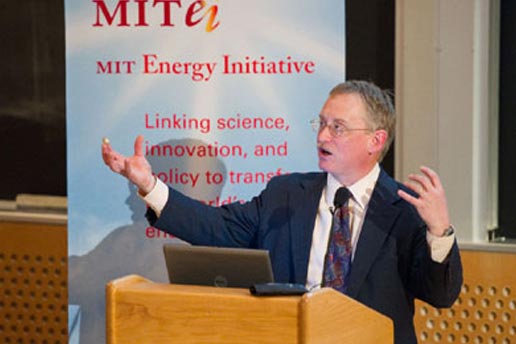 R. Neal Elliott, associate director for research of the American Council for an Energy-Efficient Economy (ACEEE). Photo: Justin Knight
R. Neal Elliott, associate director for research of the American Council for an Energy-Efficient Economy (ACEEE). Photo: Justin Knight
Improvements in energy efficiency in the building sector has only slowed, not reversed, the increase in building energy consumption, which continues to account for 40 percent of total US energy use, said R. Neal Elliott, associate director for research of the American Council for an Energy-Efficient Economy (ACEEE).
A new mini-mansion outfitted with energy-efficient appliances and weather-tight windows can still be an energy hog because its occupants own flat-panel TVs and other kilowatt-guzzling, heat-generating gadgets, said Elliott, who kicked off MIT Energy Initiative’s (MITEI) Energy Future’s Week Jan. 10 with a talk on “An Efficient Future for Energy Use in the Built Environment.”
Rethinking the location of our communities with an eye toward optimizing commutes and access to shopping, as well as focusing on modular, mid-size housing as opposed to high-rises or single-family homes will make the biggest impact on our energy future, he said. We need to change the culture and systems that support and are supported by our modes of transportation, he said. Buying Energy Star appliances and sealing windows are good, but we need to think bigger, he said.
Looking forward, he said, the focus on energy efficiency in buildings will need to shift to systems rather than components. This shift will involve transformations in how we build and where and how we live. “We need to take a more holistic approach to our communities,” said Elliott, who has written about energy efficiency programs and policies at ACEEE, the Washington, DC.-based energy think tank.
Thanks to new technologies, buildings can optimize energy use and anticipate energy needs through intelligent sensors that monitor, control and optimize a building’s energy systems during peak and off-peak periods, he said. Wind turbines and photovoltaics are becoming more common as individual building add-ons that reduce the overall load on the system, he said.
A building or house made from modular components assembled with pneumatic tools in an environment-controlled manufacturing facility will trump a traditional, site-built structure in energy efficiency every time, Elliott said, citing the example of a hotel in China, assembled from prefab components in six days, that meets the equivalent of silver LEED certification. Because of this, “we may need to tear down a lot of what we have out there,” he said. While it’s true that “retrofits can have a profound impact on the average building—reducing energy consumption by 50-70 percent–it takes a new, thoughtfully designed structure to get to a net zero” carbon footprint, he said.
Where we live and work are going to be critical. The trend is toward smaller, denser urban sectors where people live, work and shop close to home and have greater access to public transportation. This will counter the post-World War II suburban sprawl spawned by the automobile that led to skyrocketing per capita energy consumption. “We need to move back to the ‘streetcar city’ with access to transit rather than a hub-and-spoke system that funnels everyone into the urban center,” he said, citing a book by sustainable urban design expert Patrick Condon.
With these changes, Elliott is optimistic about America’s energy future. “Our economy and our environment are counting on us to make the right choices over the next 40 years,” he said.